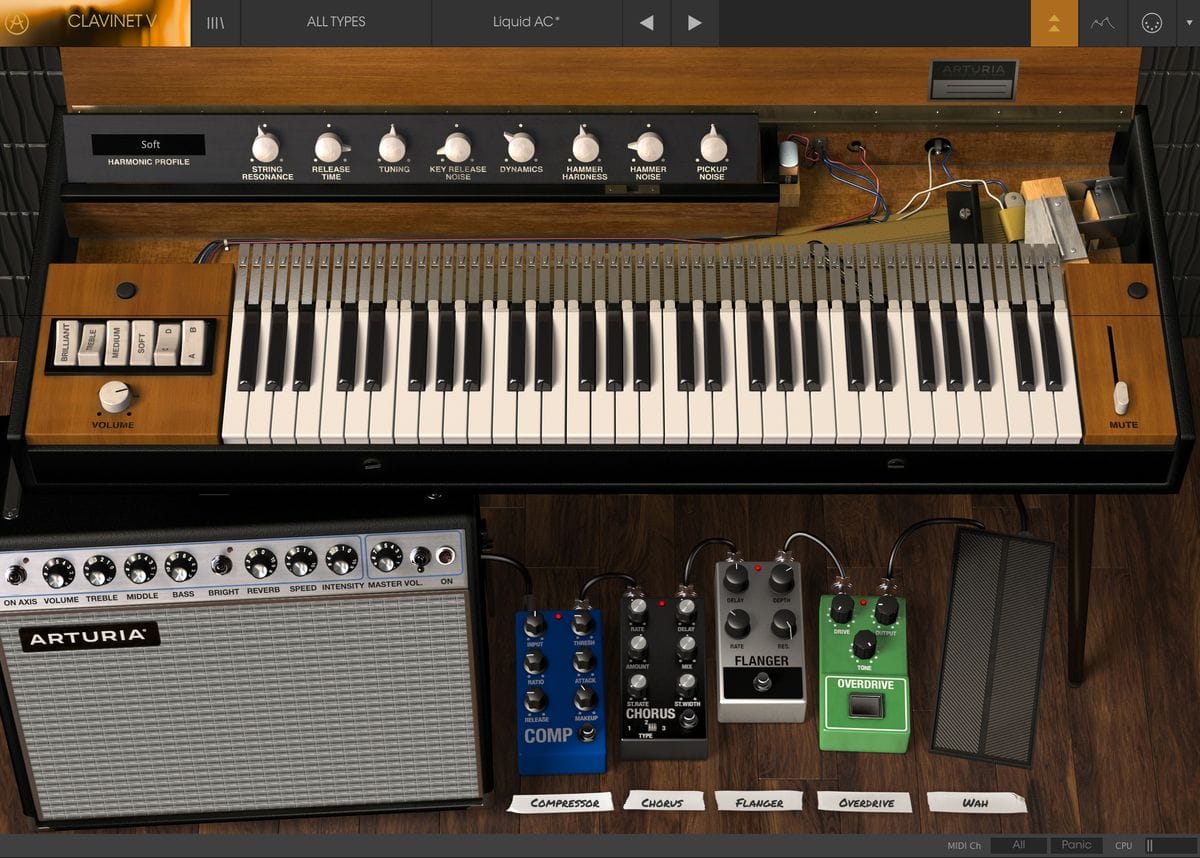That’s where
Clavinet V is different
Almost every keyboard has a handful of Clav patches. Almost none get it right.
Our physical modeling technology creates a detailed audio hologram of the Clavinet. Instead of a sampled snapshot of a sound, you get a spot-on virtual Clav that lives and breathes. It barks and sparkles just like the real deal and will draw out musical ideas you didn’t know you had.
Even the golden ears in your audience will think you used the real thing.
All of the Vibe
Tweak the same controls as on the original and Clavinet V faithfully renders the results. No settling for one-size-fits all patches here!
None of the Hassle
Vintage Clavs are hunted to extinction on the used market and expensive to restore. Clavinet V will never need tuning or repairs.
Funkmaster
Soul, rock, R&B, hip-hop, dance, prog … nothing adds groove and cred to your productions like a Clav.
Radio Ready
Play straight or through built-in modeled FX from back in the day. It’s never been easier to drop a Clav sound perfectly into a live or recorded mix.
How does it work?
You can strum or pick a guitar, but you can also mash one finger onto the fretboard and the string will vibrate.
This was the core of the “hammer-on” technique Eddie Van Halen made famous. Make a keyboard do that, give it a string for every note, add pickups like a guitar, and you have a Clav.
The Clavinet had humble beginnings. German company Hohner — known for harmonicas and accordions — aimed a series of electrified keyboards at classical practice and recital. Designer Ernst Zacharias had tried other techniques and materials, beginning with the Cembalet in the 1950s. It plucked a reed using a motion like a harpsichord. Next, the Pianet family had foam pads that actually stuck to the reeds. Pressing keys unstuck the pads, making the reeds vibrate.
Discover the history of Clavinet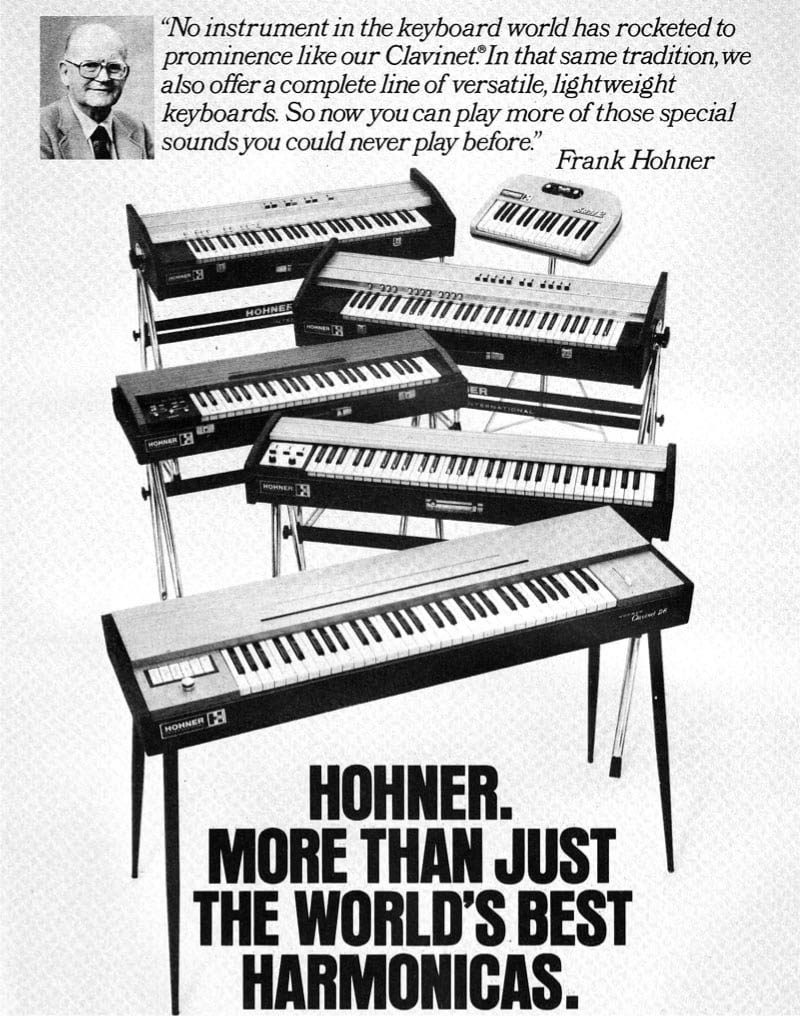
A real Clav,
piece by piece
Meticulous component-level modeling is the secret to authentically recreating a legend.
The Clavinet is a unique combination of discrete electro-acoustic components that each have a dynamic life force all their own as they interact with each other. Capturing that behaviour - and subsequently that sound - requires more than sampling. Instead, we’ve modeled each component to bring the signature sound and continuous playing dynamics of the Clavinet fully to life under your fingertips.
Physical Modeling
The Clavinet sound comes from its strings contacting metal plates, giving it that characteristic bright sound similar to a slapped guitar or bass string. Releasing the key triggers the yarn damping mechanism. Each of these components has been remodeled to accurately reflect differences in volume and brightness depending on how hard you play - right down to the master damper slide for softer muted plucked sounds.
Algorithmic circuit emulation
The Clavinet’s string vibrations are converted to an electric signal via a pair of 6-core humbucking pickups similar to those found in electric guitars, Left-hand rocker switches determine the pickup engagement and phase, as well as all-or-nothing passing of low, mid, and high frequencies. We emulated these individual parts of the Clavinet’s chain using advanced algorithms to give you the exact response you’d expect from the real thing. Clavinet V is as close as it gets.
So Simple,
So Flexible
All the tonal control of the Clavinet D6.
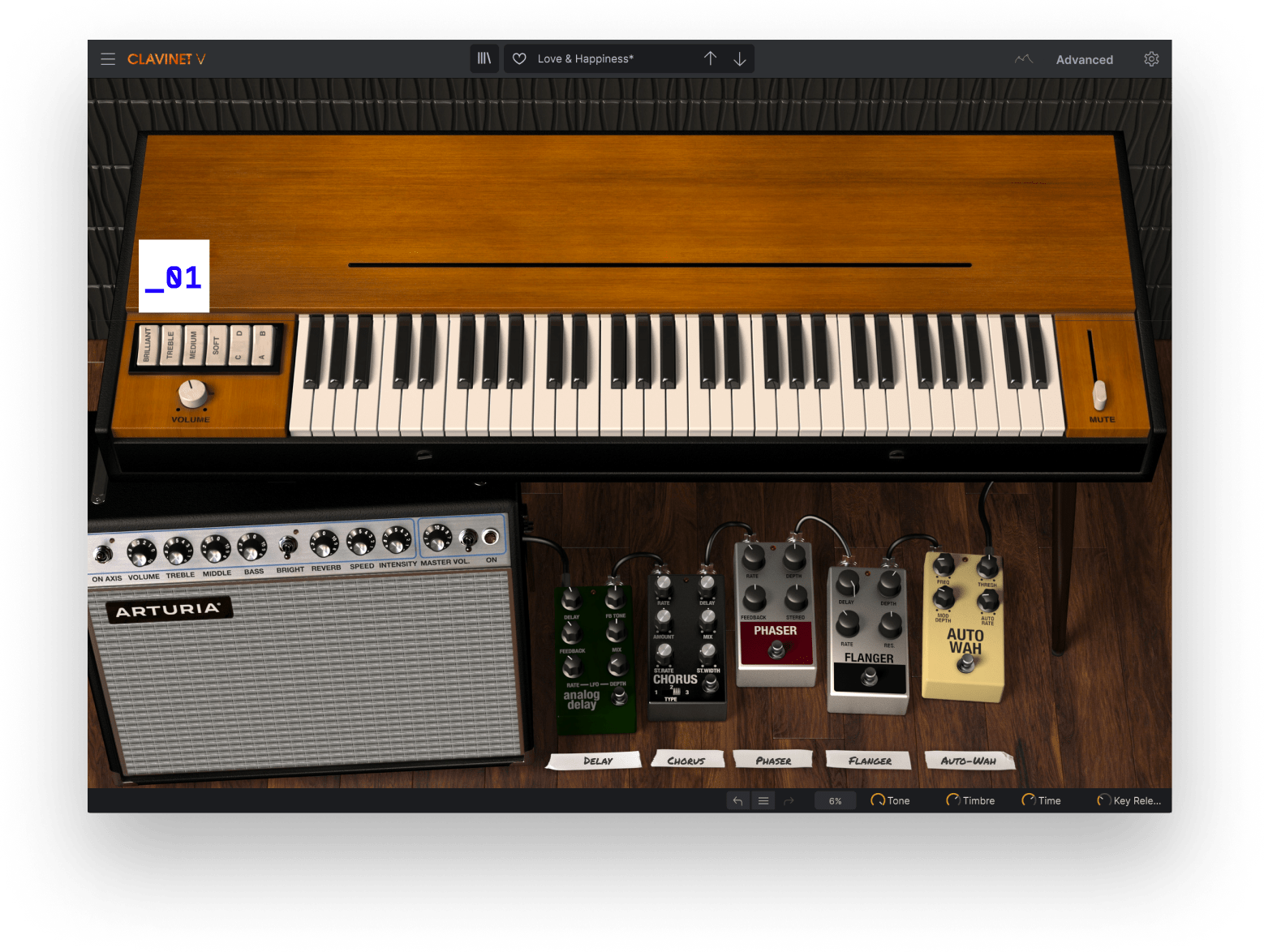
Go full and mellow, sharp and nasal, or anywhere in between. Four filter switches emphasize different parts of Clavinet V’s frequency range.
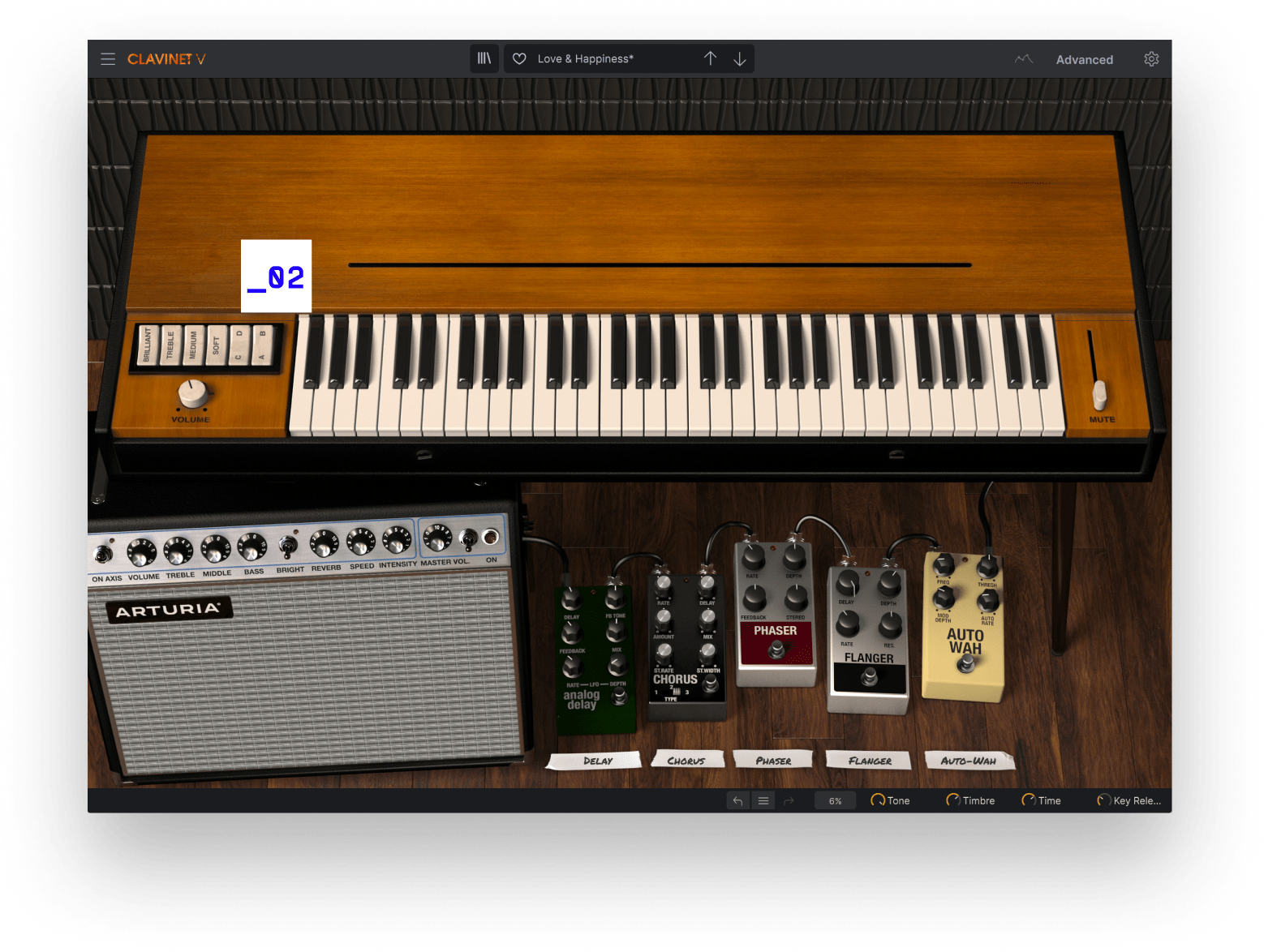
Take even more timbral control with the pickup switches — choose to hear one pickup or the other, both in phase, or both out of phase.
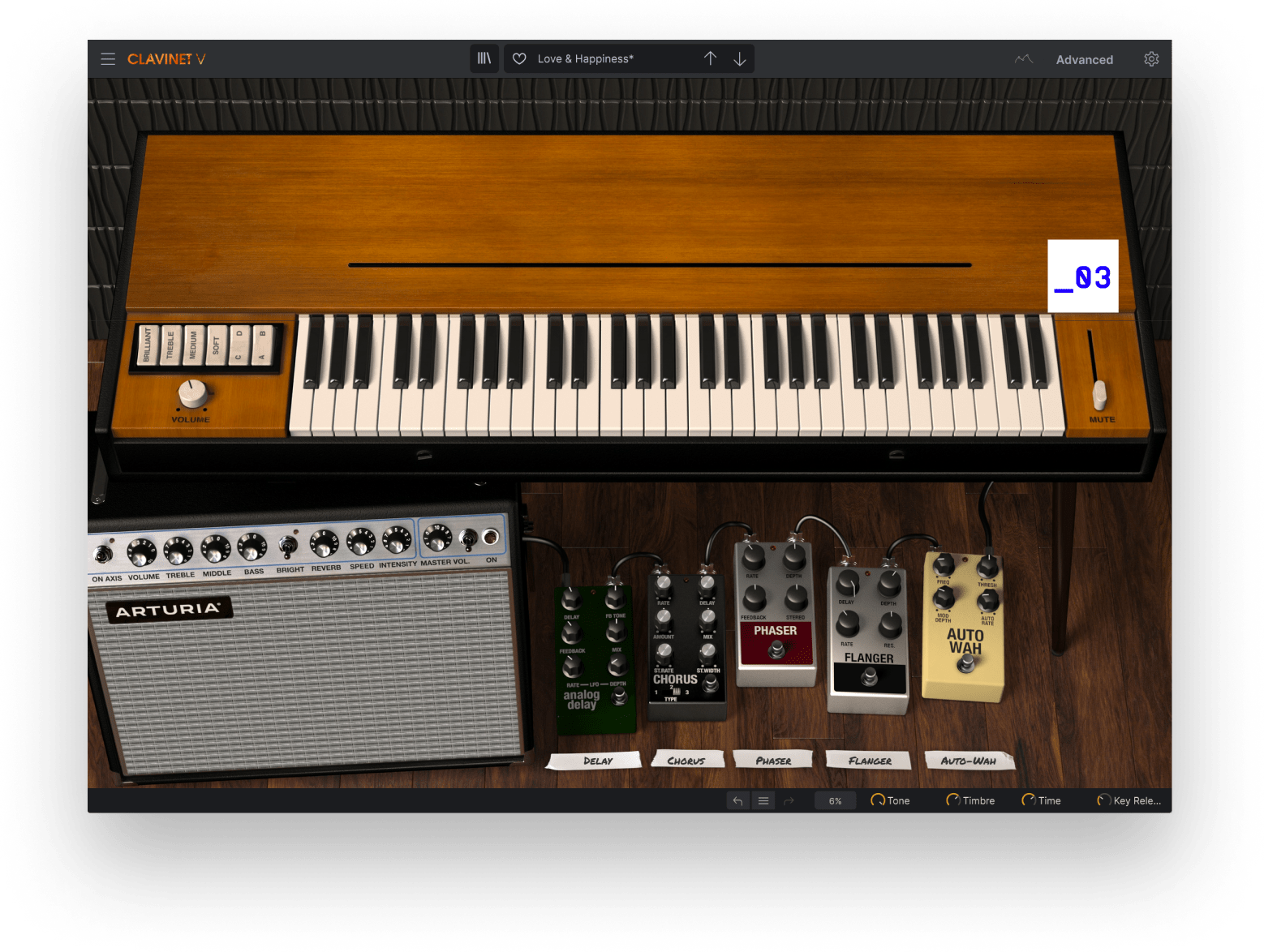
We’ve modeled the Clavinet’s physical mute mechanism, which affects both sustain and brightness.
What we
added
Clavinet V lets you fine-tune all the mechanical and electrical nuances of the real thing - and beyond.
Physical modeling gives you infinitely more control than sampled-based instruments - even more than the real thing. Add effects to the mix, and you’ve got a complete rig at your fingertips.
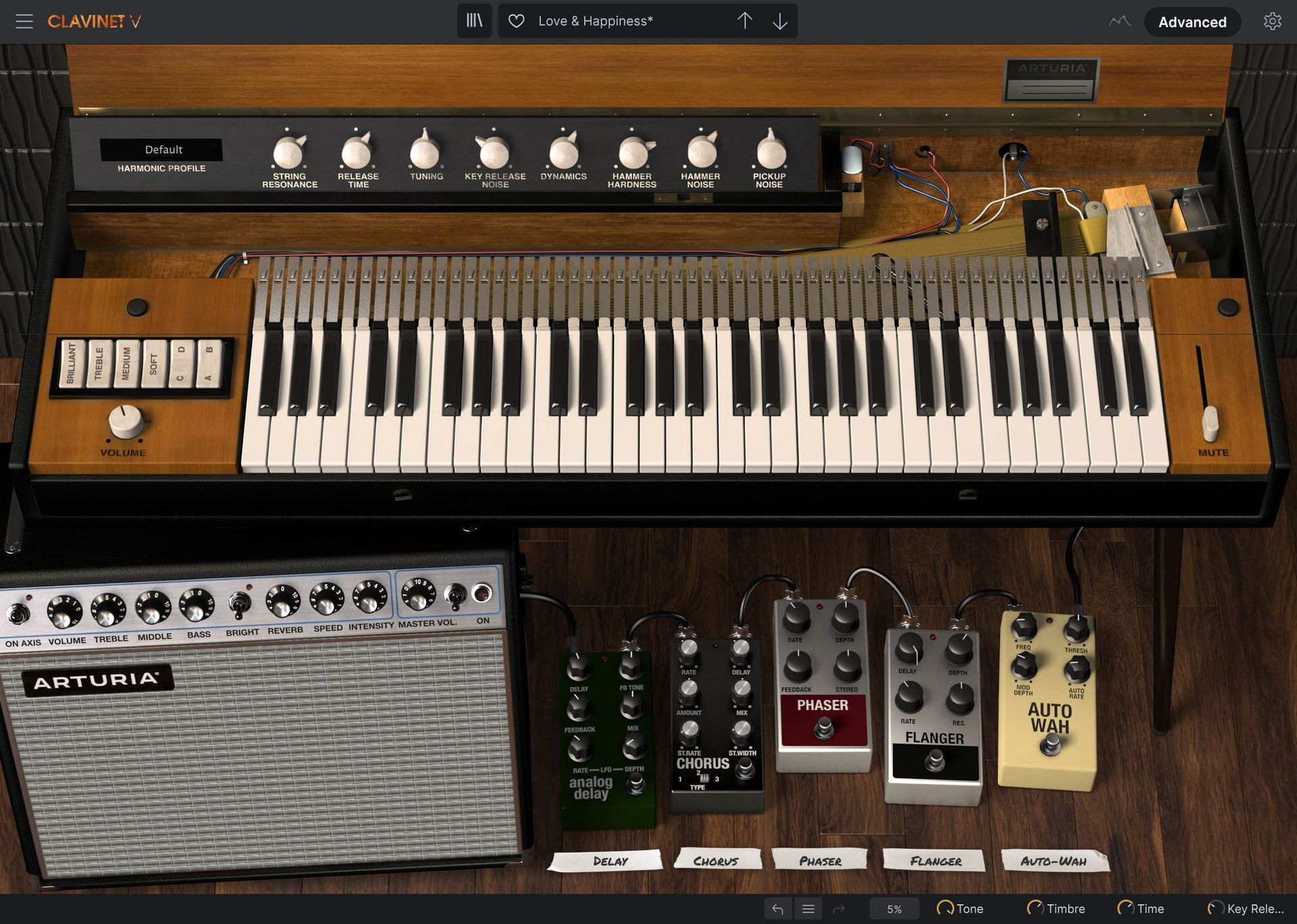
_1
_2
_3
_4
_5
01. Cry, Baby
How can a Clav get any funkier? With a wah-wah! Choose a MIDI-assignable pedal or auto-wah.
02. Turn On, Trip Out
Four more stompbox slots host authentic vintage phaser, flanger, chorus, delay, overdrive, and compressor pedals, and even a unique vocal filter for talkbox effects.
03. Amp It Like the Pros
The modeled Twin-style amp simulator offers 3-band EQ, reverb, tremolo, and plenty of attitude.
04. Profile Picture
Change Clavinet V’s entire character with different harmonic profiles.
05. All the Details
No two Clavinets are exactly alike, which is why you can adjust variables like string resonance, key-off noise, hammer hardness, and more.
06. Define Your Touch
Optimize Clavinet V’s response for your playing style and MIDI controller in the velocity curve editor. It even saves curve presets.
In Aktion
anhören
Everyone knows and loves the “Superstition” sound, but just like the original, Clavinet V has many more musical and tonal tricks up its sleeve.
Physical modeling and algorithmic emulation combine in the Clavinet V to give you all the variations of authentic Clavinet sounds behind countless funk, pop, R&B and rock hits. Check out these demos to experience its mind-expanding range.
Fast Lane
Paolo Negri
Funky
Christian Laffite
Movie
Christian Laffite
Presets
From fundamental funk to processed prog, our acclaimed sound designers have filled the factory soundbank with Presets that capture any sound the original Clavinet could create — and even a few that it couldn’t.
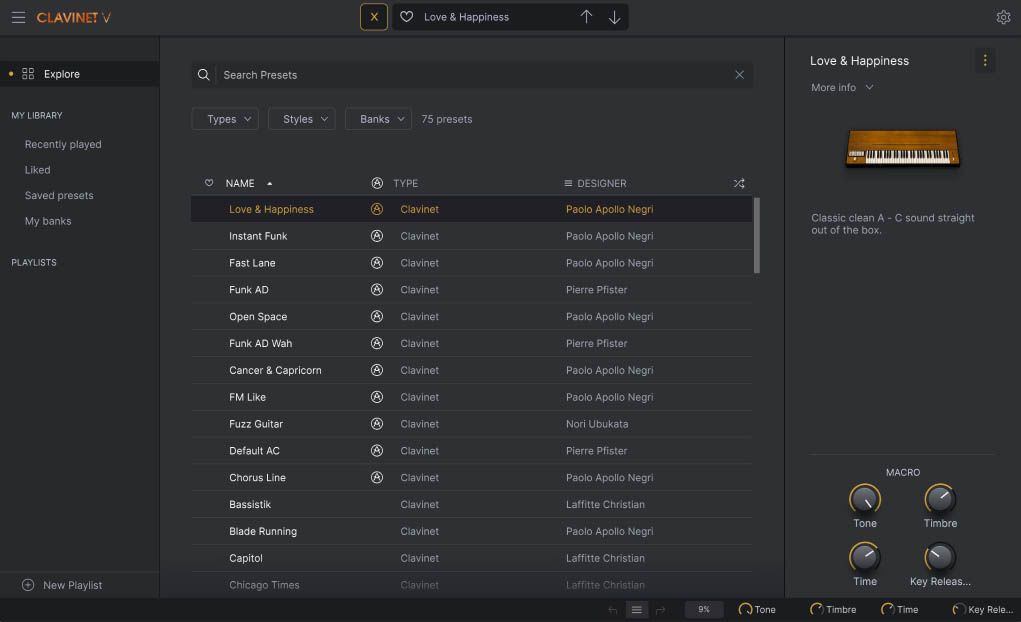
Artistscorner
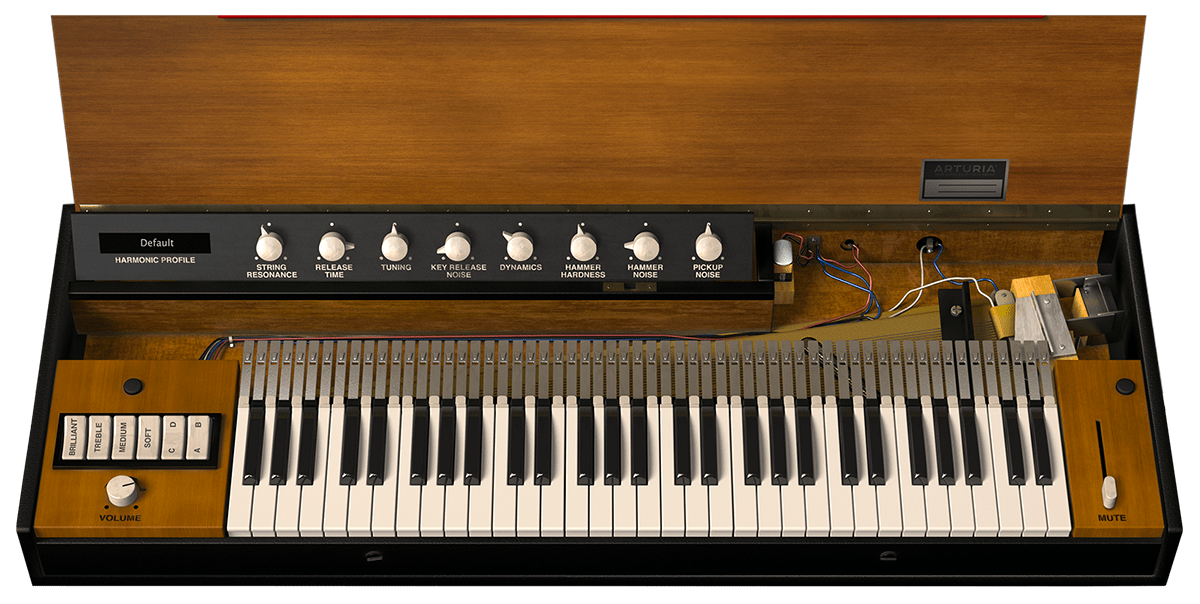
Enthalten in
V collection
Legendäre Keyboards wiederbelebt
Dieses Instrument ist auch Bestandteil der V Collection – deiner kompletten Wunschbesetzung von legendären Synthesizern, Orgeln, Pianos und Instrumenten, die Keyboard-Geschichte geschrieben haben. Diese wurden mit den fortschrittlichsten Technologien für authentischen Realismus emuliert und mit neuen kreativen Möglichkeiten ausgestattet. Egal, ob als DAW-Plug-In im Studio oder als Standalone-Version bei Auftritten, die V Collection gibt dir die besten Tasten-Instrumente aller Zeiten für eine sofortige Inspiration in deine Hände.
Erfahre mehr
Enthalten in
V collection
Legendäre Keyboards wiederbelebt
Dieses Instrument ist auch Bestandteil der V Collection – deiner kompletten Wunschbesetzung von legendären Synthesizern, Orgeln, Pianos und Instrumenten, die Keyboard-Geschichte geschrieben haben. Diese wurden mit den fortschrittlichsten Technologien für authentischen Realismus emuliert und mit neuen kreativen Möglichkeiten ausgestattet. Egal, ob als DAW-Plug-In im Studio oder als Standalone-Version bei Auftritten, die V Collection gibt dir die besten Tasten-Instrumente aller Zeiten für eine sofortige Inspiration in deine Hände.
Erfahre mehr
Die Features
Du brauchst

Integrierte In-App-Tutorials führen dich durch jeden Aspekt des Instruments, von individuellen Parametern bis hin zu Tipps unserer Sounddesigner, damit du dich auf deinen kreativen Moment konzentrieren kannst. Das kann doch nicht so einfach sein, ist es aber!

Mit dem Arturia Software Center kannst du deine Arturia Software an einem Ort herunterladen, organisieren und aktualisieren und alle deine Lizenzen für mehrere Geräte verwalten. Einfacher geht es nicht!

Unsere virtuellen Instrumente und Plug-Ins wurden so entwickelt, dass sie problemlos direkt in dein Setup passen. Unabhängig von deinem Style kannst du jeden Sound erkunden und gleichzeitig die volle Kompatibilität mit den wichtigsten DAWs sowohl unter Windows als auch unter macOS genießen.

Finde sofort den richtigen Sound mit dem intelligenten & optimierten Preset-Browser. Suche nach Schlüsselwörtern, nach Instrumentenart, Musikstil und nach vielem mehr - du kannst sogar deine Favoriten speichern, um diese später schnell aufzurufen.

Egal, ob du mit einer Vollbilddarstellung in unsere klassischen Instrumentenemulationen eintauchen oder kostbaren Bildschirmplatz sparen willst – die Bedienoberflächen für alle virtuellen Arturia-Instrumente können beliebig skaliert werden – ganz nach deinem Geschmack.

Unsere Instrumente sind für den nahtlosen Einsatz mit der Arturia KeyLab-Serie vorkonfiguriert - aber sie funktionieren natürlich auch mit anderen MIDI-Controllern. Und mit dabei: Makros für direkte Sound-Optimierung, einfache DAW-Integration und Standalone-Betrieb.
Phi® Powered
State-of-the-art physical modeling designed to provide real material depth to our acoustic and electro-acoustic virtual instruments.
With advanced mathematical algorithms, our engineers recreate every aspect of the original instruments, down to the finest vibrations - for a response that sounds and feels as tangible as the real thing.
Learn more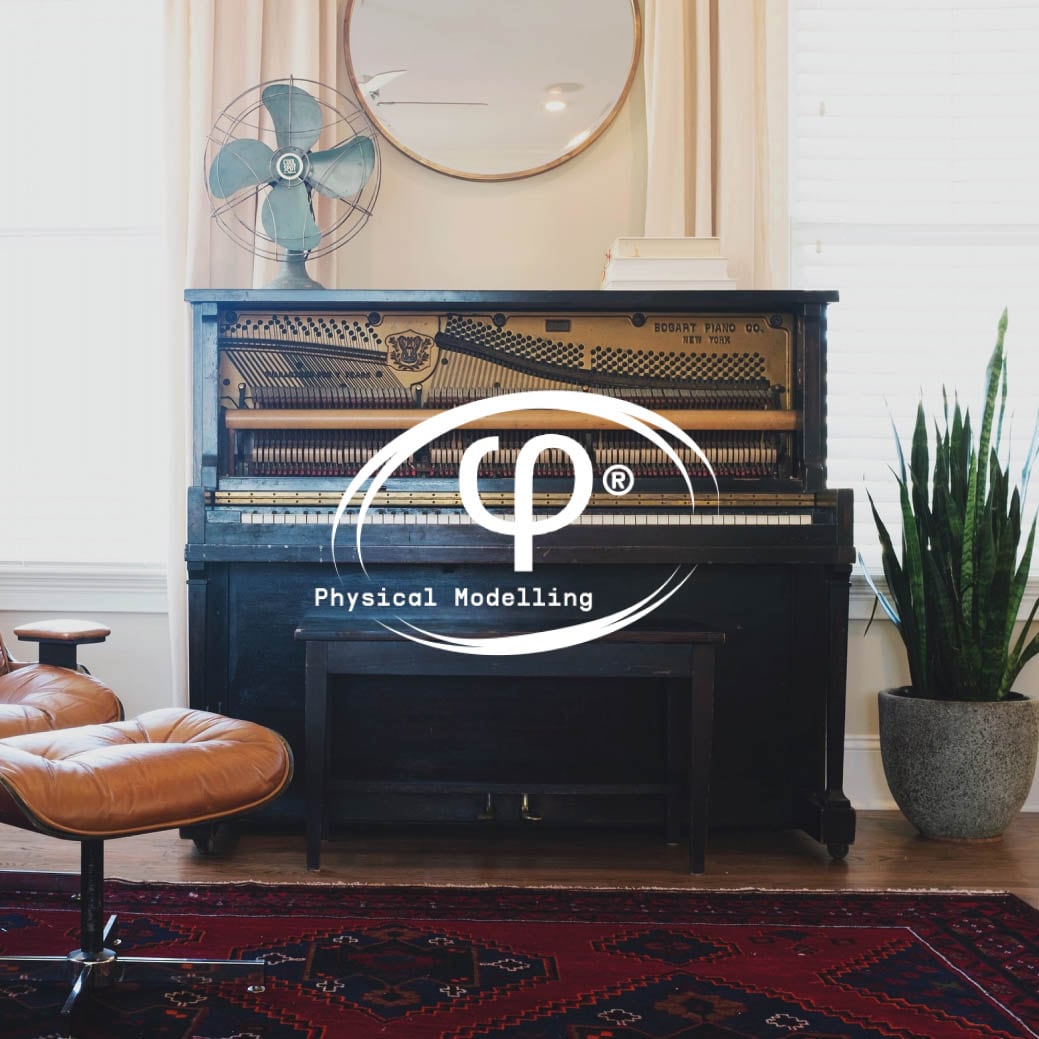
Galerie
Main Features
Advanced Physical modeling engine (no static samples)
Hohner™ Clavinet
- Mute bar
- Accurate pickups model with generated pickup noise (4 lower and upper pickup combinations)
- Circuit Modeled tone circuit (4 bands, brillant, trebble, medium, soft)
- Volume control
Fender Twin amp
- Modeled spring reverb
- On and off axis mic placement
- Tone controls
- Mono vibrato
- Effects are post output circuit
Output effects where you can change the order
- Wah, auto-wah
- Flanger
- Phaser
- Compressor
- Chorus
- Analog Delay
- Overdrive
- Vocal Filter
Advanced mode for editing the model itself
- Harmonic profile selections
- Velocity curve editor
- String resonance
- Release time
- Tuning
- Key release noise
- Dynamik
- Hammer hardness
- Hammer noise
- Pickup noise
74 factory presets
Easy to use MIDI mapping
Betriebssystem-Spezifikationen
Windows
- Win 10+ (64bit)
- 4 GB RAM
- Vierkern-CPU, 3.4 GHz (4.0 GHz Turbo-boost)
- 3GB freier Festplattenspeicher
- OpenGL 2.0 kompatible GPU
- ARM Prozessoren werden unter Windows nicht unterstützt
Systemvoraussetzungen
- Arbeitet als Standalone, VST, AAX, Audio Unit, NKS (nur mit 64-Bit DAWs).





Apple
- Mac OS 11+
- 4 GB RAM
- Vierkern-CPU, 3.4 GHz (4.0 GHz Turbo-boost) oder M1 CPU
- 3GB freier Festplattenspeicher
- OpenGL 2.0 kompatible GPU
Arbeiten mit dem ASC
- Eine elegante und einfache Lösung, die dir bei der Installation, Aktivierung und Aktualisierung der Arturia-Softwareinstrumente hilft.
Alle auf dieser Seite genannten Hersteller- und Produktnamen sind Marken der jeweiligen Eigentümer und stehen in keiner Weise mit Arturia in Verbindung. Die Markenbezeichnungen anderer Hersteller dienen ausschließlich der Kennzeichnung der Produkte derjenigen Hersteller, deren Eigenschaften und Klang bei der Entwicklung analysiert wurden. Alle Namen von Geräten, Entwicklern und Herstellern werden nur zur Veranschaulichung und zu Bildungszwecken aufgeführt und stellen keine Verbindung oder Billigung durch einen Geräte-Entwickler oder -Hersteller dar.



